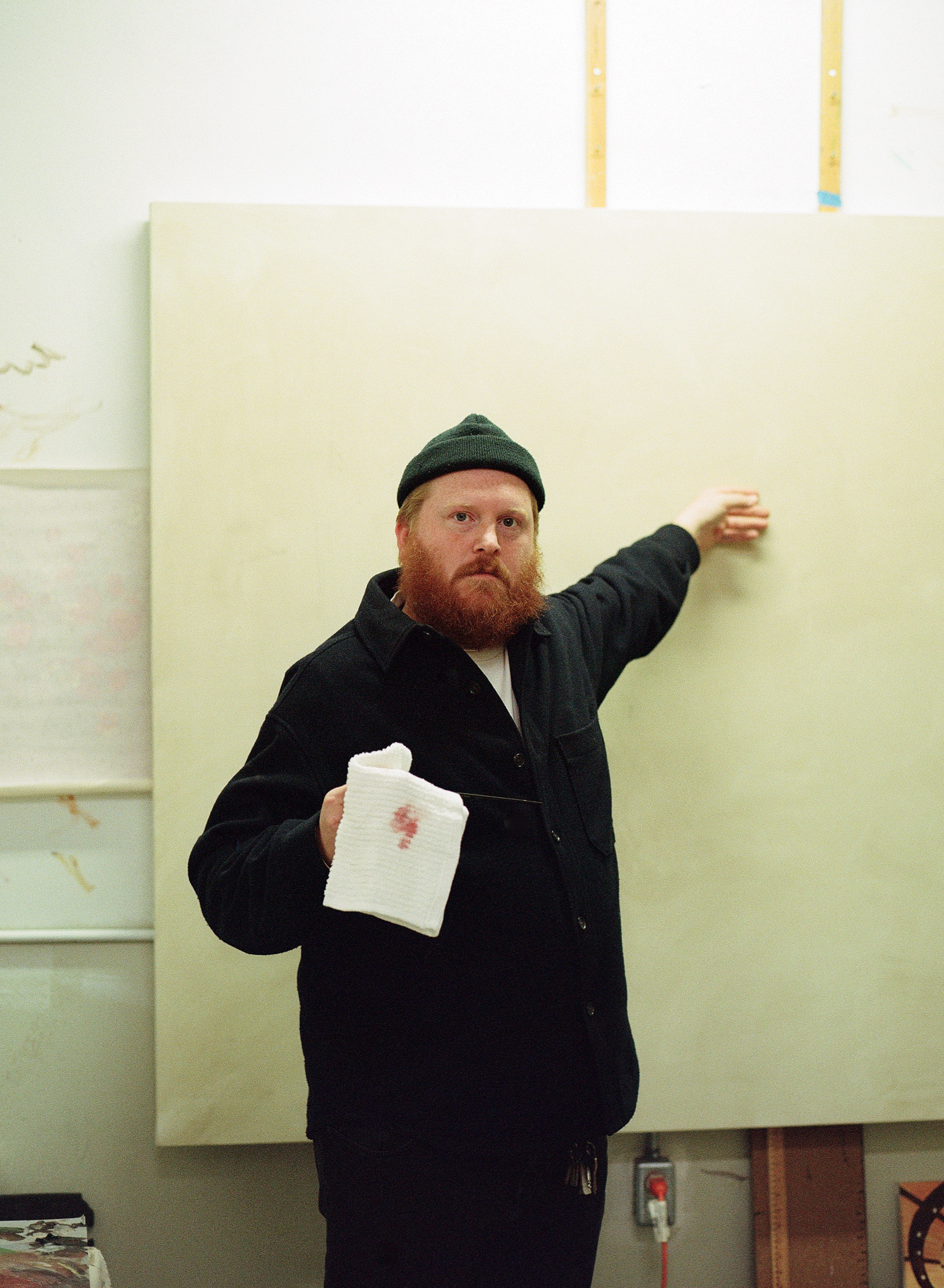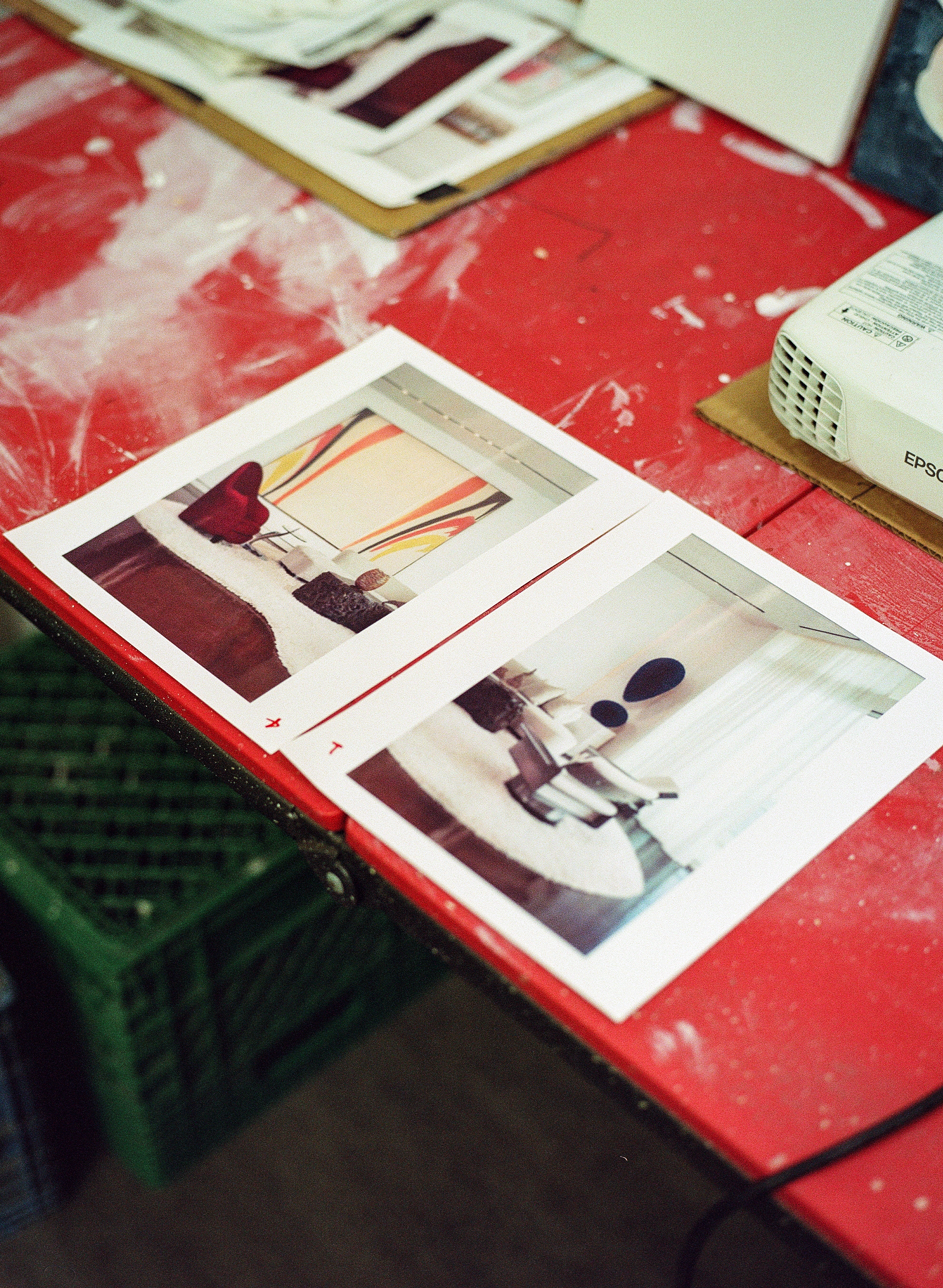
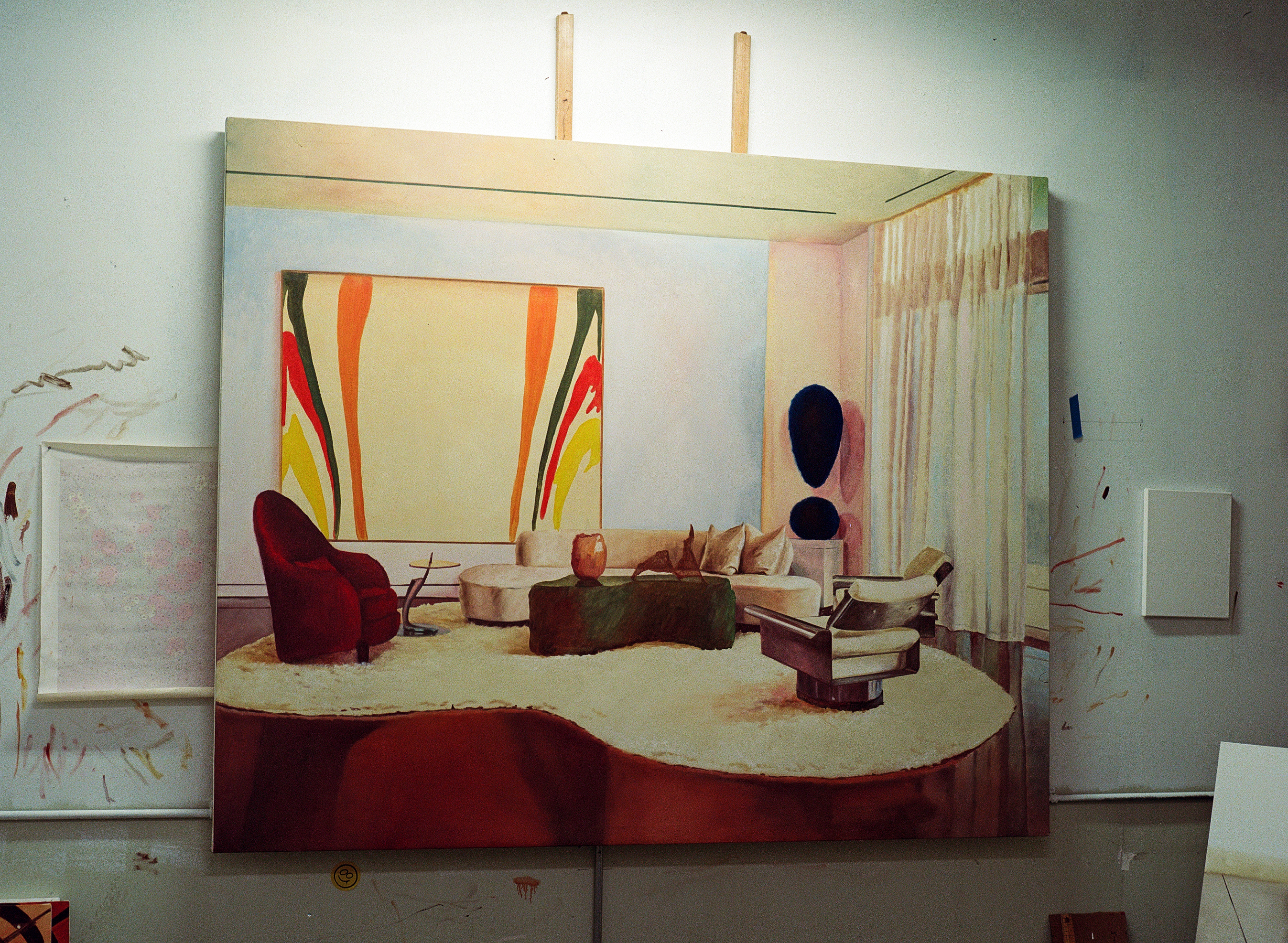

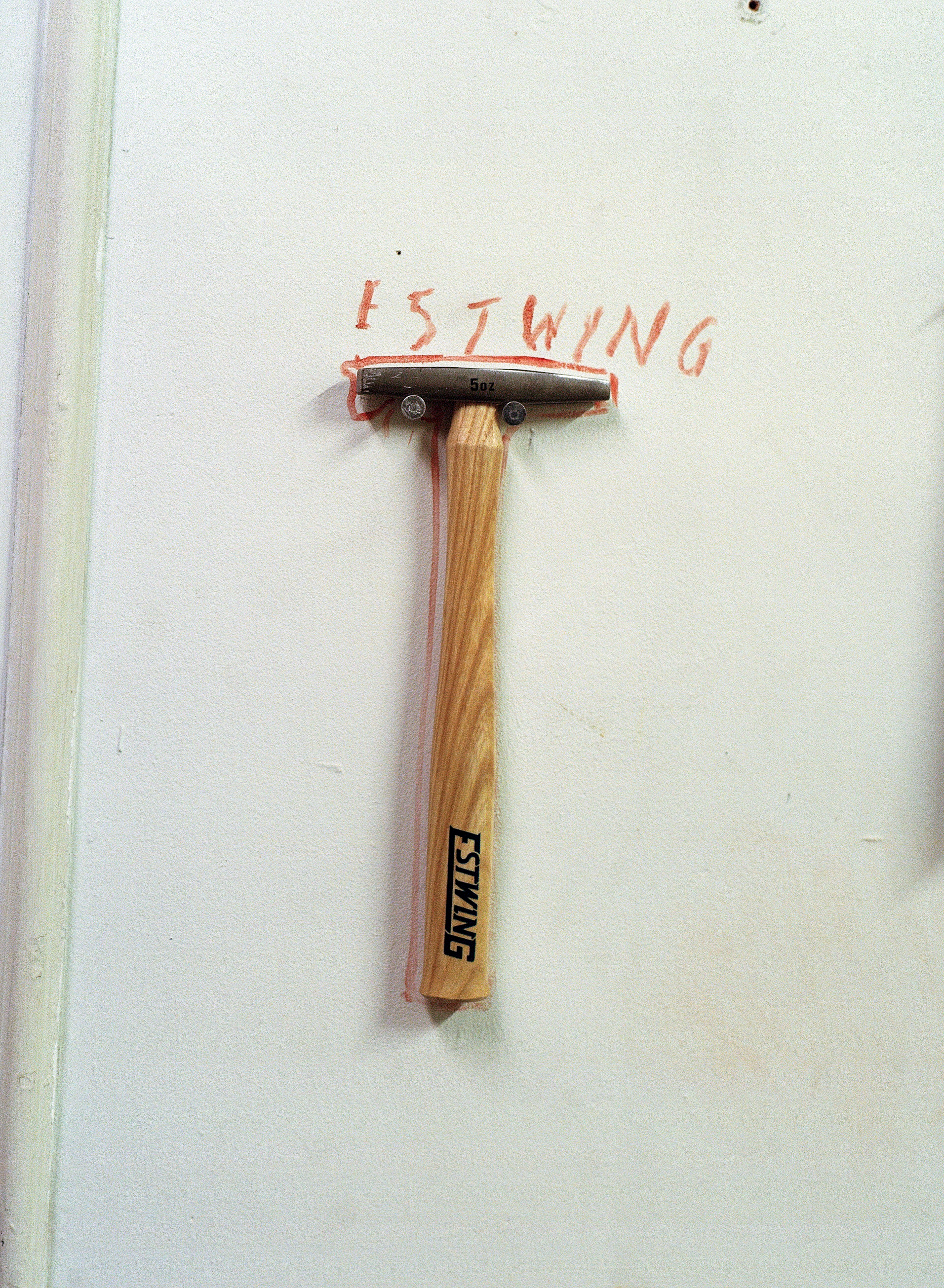
I first met Brian Rideout over a decade ago. We were both living in Toronto and trying to make something out of ourselves —something Brian was already having a bit more success with at the time.
We had met through our mutual friend Brad Tinmouth, who in 2009 was running Butcher Gallery, a one room gallery above a butcher shop on Queen East (his living room). From the few events I saw firsthand, Brian occasionally showed black & white graphite grid drawings in the space, I didn’t know he could paint. Closing up shop in 2010, Brad would go on to work for Kent Monkman as his studio manager, eventually hiring Brian as an assistant painter. Just a quick summary of the stepping stones that would lead to Brian setting off in his own direction, happening upon the images that would become the American Collection Paintings —and at the time of our conversation —be a week ahead of his sophomore show Living Well at Tile Blush, during Miami’s Art Basel.
I caught up with him in his Parkdale studio, to discuss the process of shipping paintings down to Miami, Kent Monkman, the road so far, and of course, painting.
We had met through our mutual friend Brad Tinmouth, who in 2009 was running Butcher Gallery, a one room gallery above a butcher shop on Queen East (his living room). From the few events I saw firsthand, Brian occasionally showed black & white graphite grid drawings in the space, I didn’t know he could paint. Closing up shop in 2010, Brad would go on to work for Kent Monkman as his studio manager, eventually hiring Brian as an assistant painter. Just a quick summary of the stepping stones that would lead to Brian setting off in his own direction, happening upon the images that would become the American Collection Paintings —and at the time of our conversation —be a week ahead of his sophomore show Living Well at Tile Blush, during Miami’s Art Basel.
I caught up with him in his Parkdale studio, to discuss the process of shipping paintings down to Miami, Kent Monkman, the road so far, and of course, painting.

SCOTT PILGRIM - I’ve heard about the early days and how you got started, can you give us a rundown on what led to you working with Kent? What was the hiring experience like?
BRIAN RIDEOUT - I have a good friend, Brad Tinmouth, who had a gallery at the time called Butcher Gallery, he was showing my work in a 4 story walk up at Sherbourne and Queen. He was, and is to this day a huge supporter of my work (and one of my dearest friends). He had recently been hired on as Kent’s studio manager / assistant / catch-all, when Kent put out a call for painting assistants Brad came to me and quickly got me a trial period. I was still working at a gallery, so I’d work a full day there and then go put in 5 or 6 hours in the evening at Kent’s studio. That went on for a while, I think about a month, then they offered me full time, and that led to about 5 years of work.
SP - Was there anything in particular you gleaned from the time spent working there?
BR - I’d say the two things I learned most from working for Kent was 1 - how to do the job, as in, to work on a schedule, paint 8 hrs a day, and get the work done. 2 - how to manage the work (or career if you will) who do you need to know, what are the peripheral jobs that need to be done, how to plan your next moves, how to grow your practice, those kinds of things.
BRIAN RIDEOUT - I have a good friend, Brad Tinmouth, who had a gallery at the time called Butcher Gallery, he was showing my work in a 4 story walk up at Sherbourne and Queen. He was, and is to this day a huge supporter of my work (and one of my dearest friends). He had recently been hired on as Kent’s studio manager / assistant / catch-all, when Kent put out a call for painting assistants Brad came to me and quickly got me a trial period. I was still working at a gallery, so I’d work a full day there and then go put in 5 or 6 hours in the evening at Kent’s studio. That went on for a while, I think about a month, then they offered me full time, and that led to about 5 years of work.
SP - Was there anything in particular you gleaned from the time spent working there?
BR - I’d say the two things I learned most from working for Kent was 1 - how to do the job, as in, to work on a schedule, paint 8 hrs a day, and get the work done. 2 - how to manage the work (or career if you will) who do you need to know, what are the peripheral jobs that need to be done, how to plan your next moves, how to grow your practice, those kinds of things.

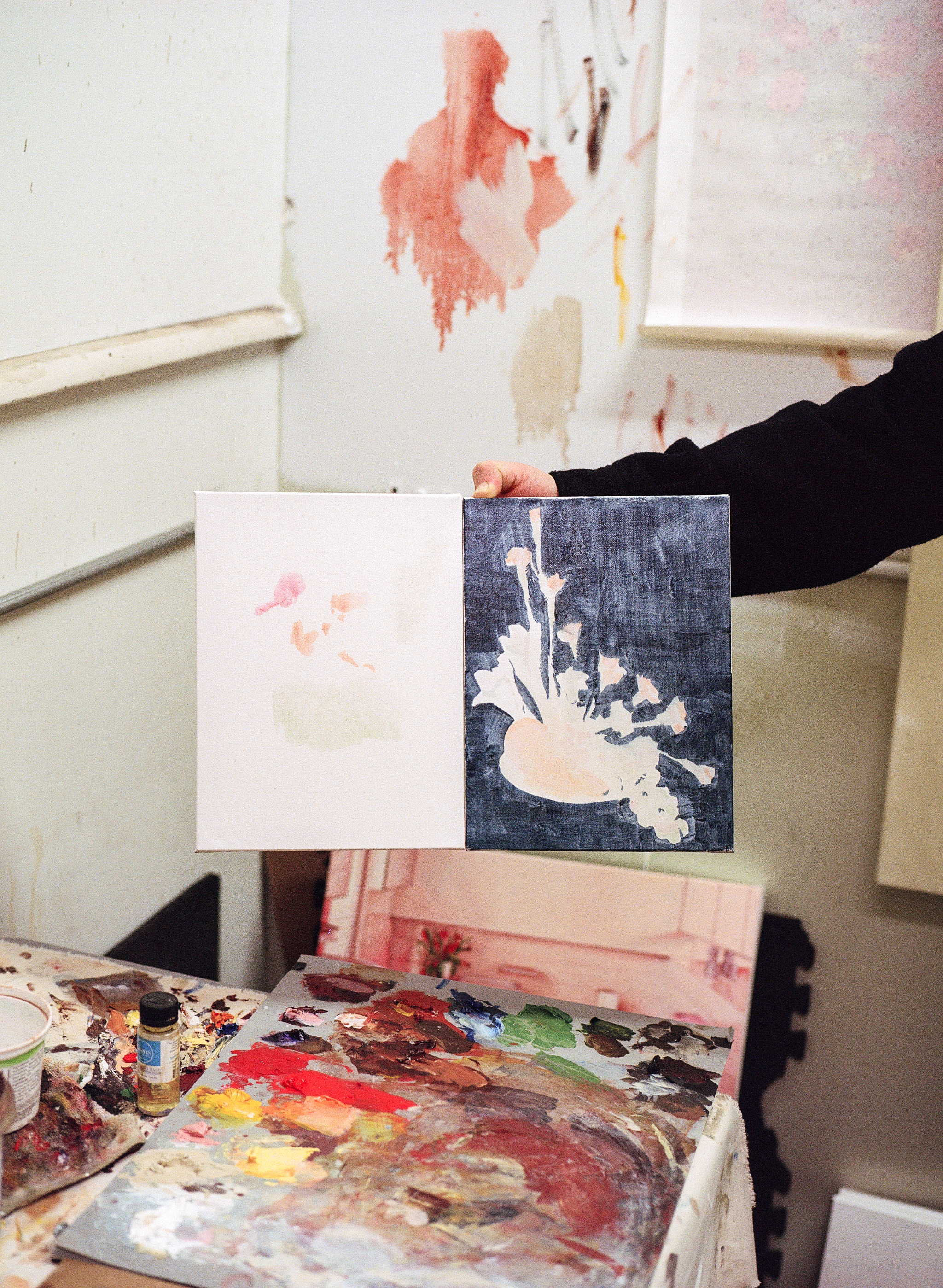
SP - How did you go from working for Kent to the American Collection Paintings?
BR - Kent put together a show in 2013 for all his assistants at Francois Oullette (PFOAC) in Montreal. One of the paintings was part of that, then after things just started moving.
SP - Ah, so you were already working on those pretty early on?
BR - Yeah, about 8 years ago I did the first one, it was before this idea of the American Collection Paintings as a series. It was this painting of a design office that had a Matisse in it, and I thought, this is so interesting, it really touches back to Matisse’s Red Room and his studio with his paintings in it, all this history collapsing back in on itself.
That’s when I really started to think about old genre painting and 1600s Flemish Collection Paintings, where a court painter would paint the monarchy’s entire collection into one painting. Have you seen these? They’re big paintings of 2000 paintings in one painting, all super tiny. It’s very cool. That’s where the name American Collection Paintings comes from.
That lead me to thinking about how now, we have magazines to come and document all the shit rich people have in their houses, and we use to paint all that. Also it reminded me of that quote about how a majority of art has been lost in private collections. These classic paintings we’re just hiding in interior design photos in like, Home & Garden magazine.
![brian]()
SP - How did you end up finding the subject matter that became these paintings, is it just pure chance that this exists?
BR - Haha maybe, I had already been researching them a bit though. Occasionally the internet would just present itself to me and I’d come across an archive of all these perfect pictures. I’m definitely always trying to get major artists represented in the paintings though. So, it does take some time.
SP - Do you feel like part of the work is flexing that you can paint anyone’s style?
BR - These new ones, I wish you got to see them, but two of them are Basquiats and one is Robert Nava who paints very naively with spray paint. He paints things like dragons and mythological creatures, so having to figure out that style and having to reproduce becomes a whole thing. With a lot of work like that, minimalist or post modern, it’s so much about the mark and making the perfect mark first try, or else it loses it’s meaning. A lot of the process is figuring out how I’ll tackle that.
![]()
![]()
SP - How does it feel painting someone elses work and it turning out just as good? When you did the first one, what was your reaction to that experience?
BR - Well, to me the interesting thing about that is how the different things in a room can be valued conceptually. But then, when I’m working on them, every object is equally valuable, because I just have to work on it until I’ve done it right. So honestly, the carpet for instance, I spend just as much time on getting that right as I would the painting or the sculpture. So the work becomes another object in a room, which it is, and really it holds no intrinsic value, it’s just a big stupid piece of cotton and some wood.
SP - Have you ever come across one you couldn’t recreate?
BR - So far no, but I have to spend most of my time in my head figuring out how to approach each style before I even start. Like right now I have maybe 6 different ideas in mind for how I’ll recreate this piece I’m working on currently.
SP - So you haven’t done a Pollock yet
BR - I have not done a Pollock, I’m avoiding him haha.
But it’s definitely part of a process where one day I will figure out how to recreate it.
BR - Kent put together a show in 2013 for all his assistants at Francois Oullette (PFOAC) in Montreal. One of the paintings was part of that, then after things just started moving.
SP - Ah, so you were already working on those pretty early on?
BR - Yeah, about 8 years ago I did the first one, it was before this idea of the American Collection Paintings as a series. It was this painting of a design office that had a Matisse in it, and I thought, this is so interesting, it really touches back to Matisse’s Red Room and his studio with his paintings in it, all this history collapsing back in on itself.
That’s when I really started to think about old genre painting and 1600s Flemish Collection Paintings, where a court painter would paint the monarchy’s entire collection into one painting. Have you seen these? They’re big paintings of 2000 paintings in one painting, all super tiny. It’s very cool. That’s where the name American Collection Paintings comes from.
That lead me to thinking about how now, we have magazines to come and document all the shit rich people have in their houses, and we use to paint all that. Also it reminded me of that quote about how a majority of art has been lost in private collections. These classic paintings we’re just hiding in interior design photos in like, Home & Garden magazine.

Flemish Collection Painting by David Teniers - Die Galerie des Erzherzogs Leopold Wilhelm in Brüssels, 1647 - 1651
SP - How did you end up finding the subject matter that became these paintings, is it just pure chance that this exists?
BR - Haha maybe, I had already been researching them a bit though. Occasionally the internet would just present itself to me and I’d come across an archive of all these perfect pictures. I’m definitely always trying to get major artists represented in the paintings though. So, it does take some time.
SP - Do you feel like part of the work is flexing that you can paint anyone’s style?
BR - These new ones, I wish you got to see them, but two of them are Basquiats and one is Robert Nava who paints very naively with spray paint. He paints things like dragons and mythological creatures, so having to figure out that style and having to reproduce becomes a whole thing. With a lot of work like that, minimalist or post modern, it’s so much about the mark and making the perfect mark first try, or else it loses it’s meaning. A lot of the process is figuring out how I’ll tackle that.
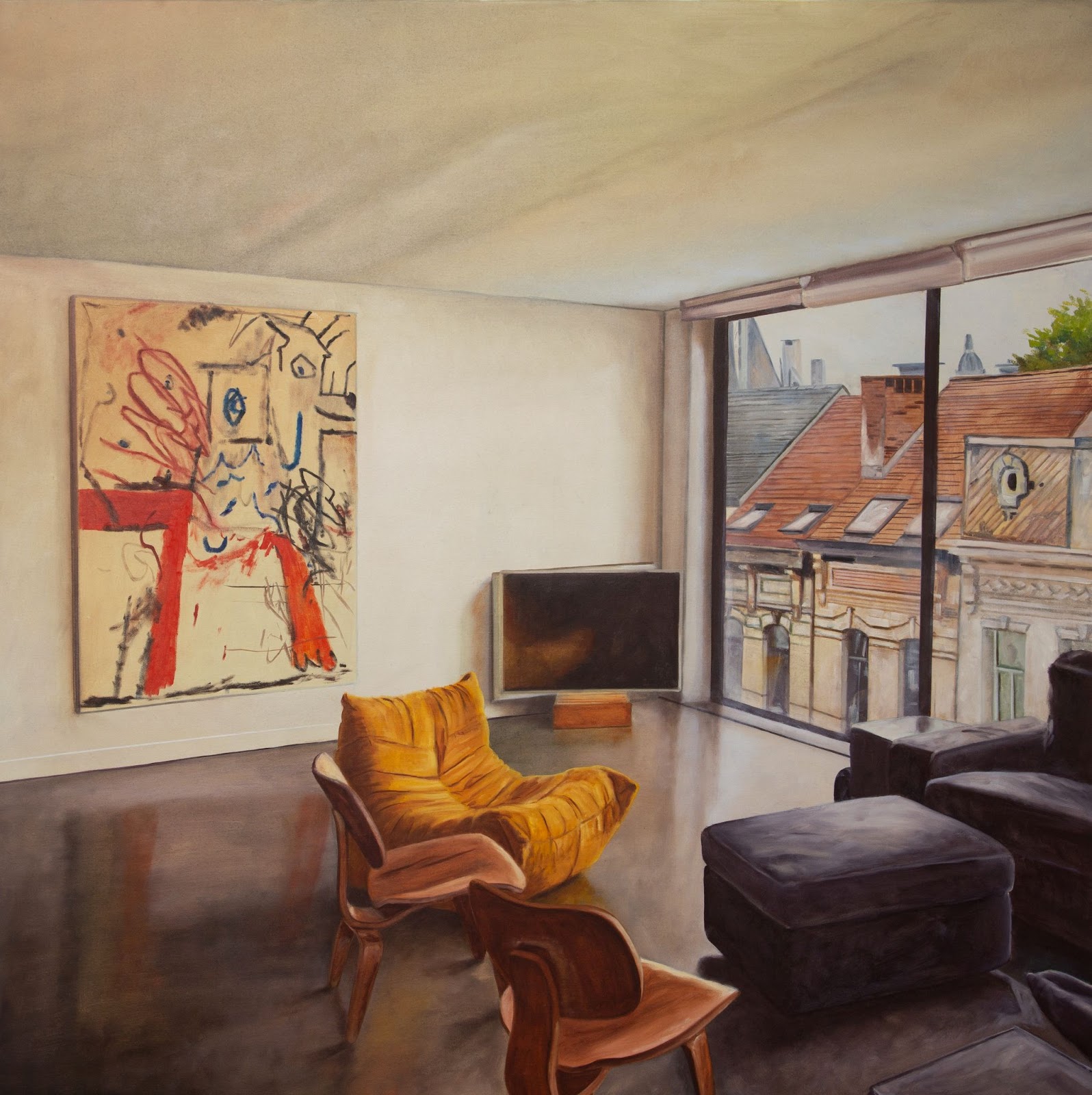

American Collection Painting 48 (Nava), American Collection Painting 47 (Basquiat, Warhol)
Brian Rideout, 2021
SP - How does it feel painting someone elses work and it turning out just as good? When you did the first one, what was your reaction to that experience?
BR - Well, to me the interesting thing about that is how the different things in a room can be valued conceptually. But then, when I’m working on them, every object is equally valuable, because I just have to work on it until I’ve done it right. So honestly, the carpet for instance, I spend just as much time on getting that right as I would the painting or the sculpture. So the work becomes another object in a room, which it is, and really it holds no intrinsic value, it’s just a big stupid piece of cotton and some wood.
SP - Have you ever come across one you couldn’t recreate?
BR - So far no, but I have to spend most of my time in my head figuring out how to approach each style before I even start. Like right now I have maybe 6 different ideas in mind for how I’ll recreate this piece I’m working on currently.
SP - So you haven’t done a Pollock yet
BR - I have not done a Pollock, I’m avoiding him haha.
But it’s definitely part of a process where one day I will figure out how to recreate it.
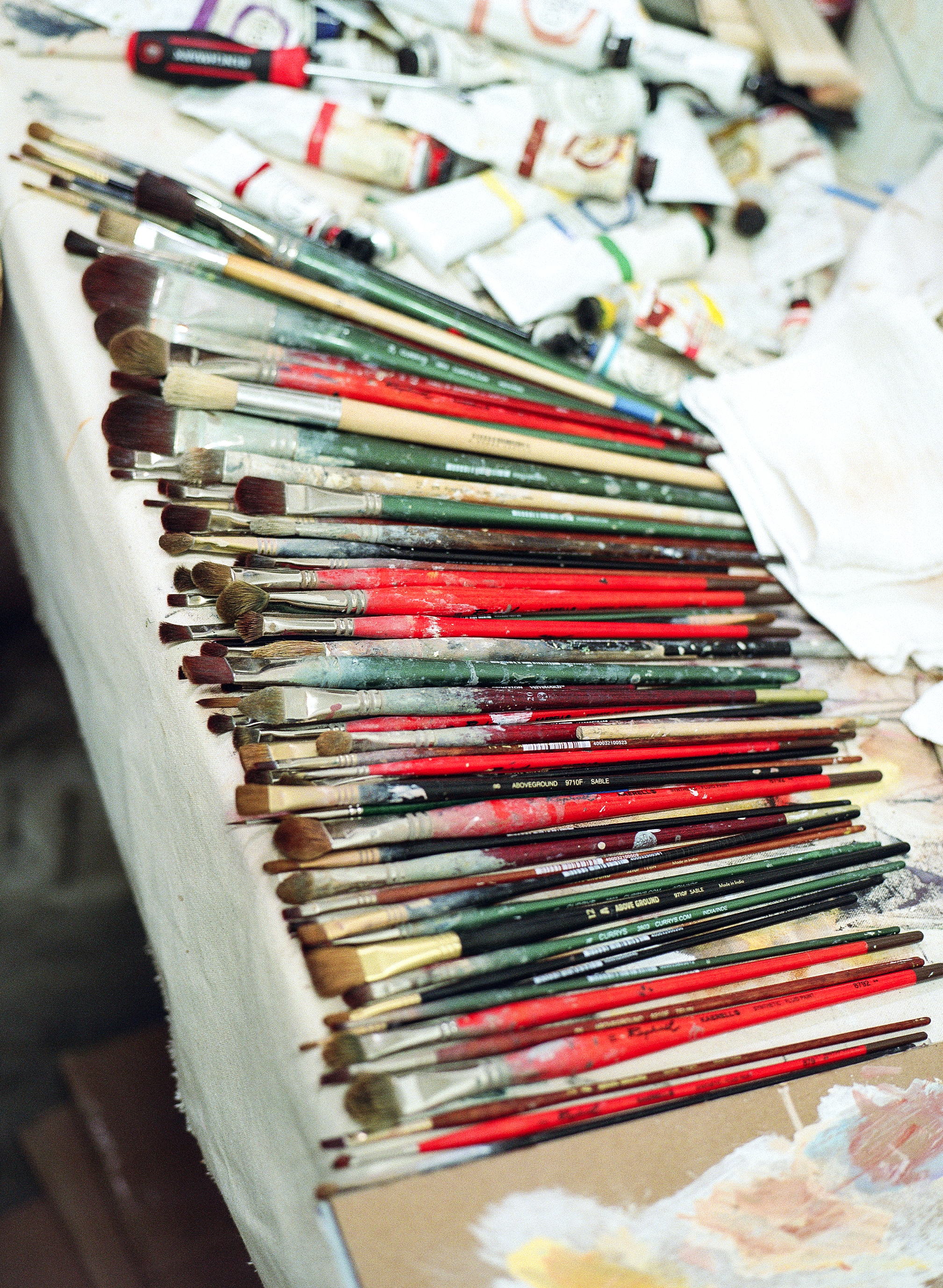

Brian in front of American Collection Painting 50 (Louis, Artschwager) prior to it’s completion
SP - Do you have any idea of how many you’ve sold to date? Were any of them commissions?
BR - I think there’s 50 total now, and not counting these ones I’m sending down to Miami, there’s maybe 3 or 4 available? So let’s say 47 total. And no, none of them were commissions by definition, some were in a sense because I wouldn’t have one available and I’d have to paint a new one. But I always choose the subject matter and the image to recreate.
SP - Who do you feel has had the biggest influence on you as an artist?
BR - One that might surprise people is probably Richard Prince, his show Spiritual America at the Guggenheim was one of the first big transformations for me. See, that’s one of the things I don’t think people connect as much because there’s such a technical aspect to my work. But, I really see myself more in line with his work, taking these photos and recreating them and saying now it’s mine.
All the other stuff like oil paint is just a symbol I align the work with, like the history that oil paint has intrinsically.
SP - How do you spend your day? How often are you painting and how long does each painting take?
BR - Well for this show, starting September I’ve basically been working Monday to Friday to get this done. I don’t like to work long hours in the studio though as I tend to get burnt out. And, like I said before I figure out so much of it in my head before I ever make a move. Also there’s a certain style to how I paint where you start from back to front and paint everything behind first, so there’s really a limit on how you long you can work before it needs time to sit and dry.
Each painting though can take around 2-3 weeks, depends on the size and the level of detail in the piece.
BR - I think there’s 50 total now, and not counting these ones I’m sending down to Miami, there’s maybe 3 or 4 available? So let’s say 47 total. And no, none of them were commissions by definition, some were in a sense because I wouldn’t have one available and I’d have to paint a new one. But I always choose the subject matter and the image to recreate.
SP - Who do you feel has had the biggest influence on you as an artist?
BR - One that might surprise people is probably Richard Prince, his show Spiritual America at the Guggenheim was one of the first big transformations for me. See, that’s one of the things I don’t think people connect as much because there’s such a technical aspect to my work. But, I really see myself more in line with his work, taking these photos and recreating them and saying now it’s mine.
All the other stuff like oil paint is just a symbol I align the work with, like the history that oil paint has intrinsically.
SP - How do you spend your day? How often are you painting and how long does each painting take?
BR - Well for this show, starting September I’ve basically been working Monday to Friday to get this done. I don’t like to work long hours in the studio though as I tend to get burnt out. And, like I said before I figure out so much of it in my head before I ever make a move. Also there’s a certain style to how I paint where you start from back to front and paint everything behind first, so there’s really a limit on how you long you can work before it needs time to sit and dry.
Each painting though can take around 2-3 weeks, depends on the size and the level of detail in the piece.


SP - You’re about to open your second show at Art Basel, can you tell me a bit more about that?
BR - Living Well, is a new show at my gallery Tile Blush in their off-site location. It’s kind of a preview of what's to come next as it had been some time since I’ve shown new work with them (due to COVID). It’s 4 big paintings, 2 small and 1 medium sized painting. The follow-up show will likely come in the new year.
SP - Is it difficult to ship paintings to Miami? It must be sort of nerve-racking having to take them apart after having only just finished them.
BR - Well, I put together all my stretchers and stretch them myself. I think it's important to have control of the process from the very beginning, and I'm very interested and invested in the whole process and have sort of a classical approach to it. I appreciate the time it takes to complete.
As for the shipping it's just undoing that process, carefully pulling all the steel-cut tacks from the back and rolling the canvases and shipping them rolled. Then, when they arrive in Miami there’s new stretchers waiting there and I can do the whole thing over again, this time with finished paintings.
SP - You mention stretching and assembling the paintings yourself, do you feel this process adds value to the piece? Do you think a buyer can tell the difference?
BR - I’m not sure if it effects the value for everyone. I do think there is a big return to traditional techniques, but that’s more about paints and salts and mediums people use.
That being said, I see poorly stretched paintings at art fairs all the time and it drives me crazy. When it comes to the general audience, I don’t think so, you have to have an eye for it. But to me it’s very obvious, you see wrinkles, or the light catches it and it looks awful. Some people I guess just don’t care. It’s usually artwork that’s a lot more expensive than mine that looks like it was made like shit.
LIVING WELL opens December 3 - January 15 at Miami’s Tile Blush. Head over to their site for more info, and follow Brian’s work here.
www.brianrideout.ca
BR - Living Well, is a new show at my gallery Tile Blush in their off-site location. It’s kind of a preview of what's to come next as it had been some time since I’ve shown new work with them (due to COVID). It’s 4 big paintings, 2 small and 1 medium sized painting. The follow-up show will likely come in the new year.
SP - Is it difficult to ship paintings to Miami? It must be sort of nerve-racking having to take them apart after having only just finished them.
BR - Well, I put together all my stretchers and stretch them myself. I think it's important to have control of the process from the very beginning, and I'm very interested and invested in the whole process and have sort of a classical approach to it. I appreciate the time it takes to complete.
As for the shipping it's just undoing that process, carefully pulling all the steel-cut tacks from the back and rolling the canvases and shipping them rolled. Then, when they arrive in Miami there’s new stretchers waiting there and I can do the whole thing over again, this time with finished paintings.
SP - You mention stretching and assembling the paintings yourself, do you feel this process adds value to the piece? Do you think a buyer can tell the difference?
BR - I’m not sure if it effects the value for everyone. I do think there is a big return to traditional techniques, but that’s more about paints and salts and mediums people use.
That being said, I see poorly stretched paintings at art fairs all the time and it drives me crazy. When it comes to the general audience, I don’t think so, you have to have an eye for it. But to me it’s very obvious, you see wrinkles, or the light catches it and it looks awful. Some people I guess just don’t care. It’s usually artwork that’s a lot more expensive than mine that looks like it was made like shit.
LIVING WELL opens December 3 - January 15 at Miami’s Tile Blush. Head over to their site for more info, and follow Brian’s work here.
www.brianrideout.ca
